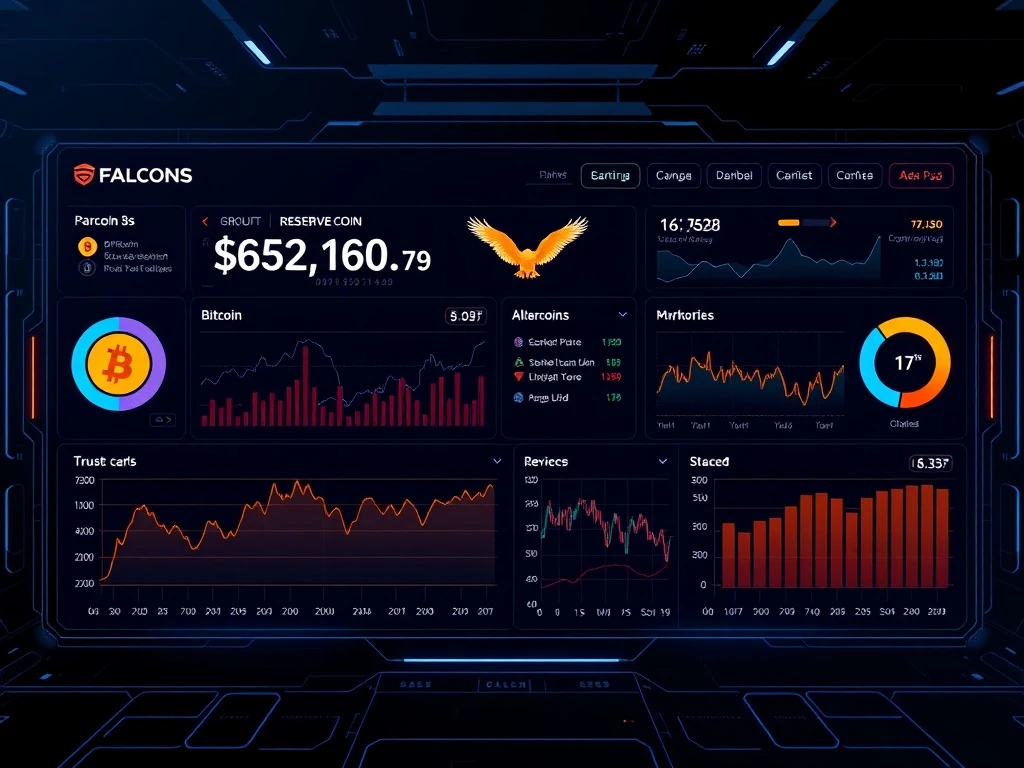Falcon Finance Unveils Revolutionary Transparency Dashboard: 108% Over-Collateralization & 12.8% APY on sUSDf

In the dynamic world of decentralized finance (DeFi), trust and transparency are paramount, especially when it comes to stablecoins. The crypto community has long called for clearer insights into the reserves backing digital assets, a demand amplified by past market instabilities. Addressing this critical need head-on, Falcon Finance has launched a groundbreaking initiative designed to bring unparalleled clarity to its synthetic stablecoin, USDf. This move isn’t just about disclosure; it’s about setting a new industry benchmark for accountability and investor confidence. If you’re invested in the future of stable, reliable digital assets, this development from Falcon Finance is poised to redefine your expectations.
Unveiling the Falcon Finance Transparency Dashboard: A New Era of Clarity
On July 25, 2025, Dubai-based Falcon Finance introduced its much-anticipated Transparency Dashboard, a real-time portal offering comprehensive visibility into the reserves that underpin its synthetic stablecoin, USDf. This isn’t a static report; it’s a dynamic, independently verified platform (by HT Digital) that updates regularly, allowing users to confirm the protocol’s solvency and operational integrity at a glance. It’s a significant step towards institutional-grade transparency in the DeFi space.
The dashboard reveals that USDf is backed by a robust $708 million in total reserves against a $660 million circulating supply. This translates to an impressive 108% over-collateralization ratio, ensuring that every USDf in circulation is backed by more than its dollar value. This goes beyond the traditional 1:1 parity, providing an additional layer of security and liquidity.
Key insights from the dashboard include:
- Total Reserves: $708 million
- Circulating Supply (USDf): $660 million
- Over-Collateralization Ratio: 108%
The reserve breakdown by asset type showcases a diversified portfolio:
- Bitcoin: $431 million
- Stablecoins: $96 million
- Altcoins & Non-Crypto Assets: $190 million
Furthermore, the dashboard details custody providers, with Ceffu and Fireblocks holding the majority of reserves. Notably, Fireblocks also safeguards $100,000 in tokenized U.S. Treasury bills, adding a layer of traditional financial stability. The inclusion of on-chain holdings further diversifies the collateral structure, strategically minimizing exposure to centralized counterparties and enhancing resilience.
Understanding USDf: The Over-Collateralized Stablecoin Setting Standards
At the core of Falcon Finance’s offering is USDf, a synthetic stablecoin designed for stability and resilience. Unlike algorithmic stablecoins that rely purely on complex code or off-chain assets without verifiable backing, USDf employs a robust, diversified collateral model. Its 108% over-collateralization ratio is a testament to Falcon Finance’s conservative risk-mitigation strategy. This structure allows the protocol to maintain its dollar peg even amidst significant market volatility, absorbing liquidity shocks effectively.
This approach directly addresses concerns about stablecoin solvency that have plagued the industry in the past. By holding more assets than its circulating supply, USDf offers a higher degree of confidence for users who prioritize stable value storage and efficient transactions. It’s a critical feature for anyone looking for reliability in their digital asset holdings.
Boosting Your Holdings: Earn a Competitive APY with sUSDf
Beyond mere transparency, Falcon Finance offers an attractive opportunity for users to earn passive income. Introducing sUSDf, a yield-bearing version of USDf, the platform provides stakers with a variable Annual Percentage Yield (APY) of 12.8%. This competitive yield is designed to reward participants while remaining sustainable within Falcon Finance’s meticulously crafted risk-cap framework.
Currently, approximately 44% of USDf’s circulating supply, or 289 million sUSDf, is staked. This balance between capital efficiency and prudent risk management highlights Falcon Finance’s commitment to long-term stability rather than short-term unsustainable gains. For those seeking to maximize their stablecoin holdings, sUSDf presents a compelling option.
Why Falcon Finance is Setting a New Standard for Trust
The launch of the Transparency Dashboard and the robust backing of USDf position Falcon Finance at the forefront of the industry’s push towards greater accountability. In an era of heightened regulatory scrutiny and investor demand for verifiable data, Falcon Finance’s proactive stance is commendable. Their approach mirrors efforts by other leading protocols to adopt real-time verification tools, directly addressing concerns about solvency and governance in the DeFi ecosystem.
The protocol plans to further reinforce accountability by publishing quarterly, independently audited reports. Users and third parties can access the dashboard directly via the provided link, fostering an environment of complete openness. By diversifying its collateral and openly publishing detailed reserve data, Falcon Finance is actively building trust and setting a new benchmark for operational integrity in the digital asset space.
The Critical Importance of Stablecoin Stability in DeFi
Stablecoin stability is the bedrock of the broader cryptocurrency market, serving as a vital bridge between volatile digital assets and traditional fiat currencies. Their role as a medium of exchange, a store of value, and a liquidity provider makes their integrity paramount. The past has shown us the devastating consequences of opaque reserve structures and failed algorithmic models, leading to significant market turmoil and loss of investor confidence.
Falcon Finance’s initiative directly confronts these challenges. By integrating a dynamic dashboard and a risk-managed yield strategy, they are not just reacting to industry demands but proactively shaping a more secure and trustworthy future for stablecoins. This commitment to diversified collateral and transparent reporting is crucial for attracting both retail and institutional capital, fostering a more mature and reliable DeFi landscape.
Falcon Finance’s commitment to transparency, underscored by its new dashboard and the robust 108% over-collateralization of USDf, marks a significant milestone in the stablecoin sector. Coupled with the attractive 12.8% APY on sUSDf, the platform is not only building trust but also offering compelling opportunities for users. This proactive approach to verifiable reserves and sustainable yield generation positions Falcon Finance as a leader in fostering a more secure and transparent decentralized financial ecosystem.
Frequently Asked Questions (FAQs)
What is the Falcon Finance Transparency Dashboard?
The Falcon Finance Transparency Dashboard is a real-time online portal that provides detailed, verifiable information about the reserves backing USDf, Falcon Finance’s synthetic stablecoin. It displays asset breakdowns, custody providers, and on-chain status to ensure full visibility and accountability.
How is USDf over-collateralized?
USDf is over-collateralized by 108%, meaning its total reserves ($708 million) exceed its circulating supply ($660 million). This provides an additional buffer of security and liquidity, ensuring the stablecoin can maintain its peg even during market fluctuations.
What is sUSDf and what APY does it offer?
sUSDf is the yield-bearing version of USDf. Users who stake their USDf receive sUSDf and can earn a variable Annual Percentage Yield (APY) of 12.8%. This yield is designed to be competitive yet sustainable within Falcon Finance’s risk management framework.
Who verifies the reserve data on the dashboard?
The data displayed on the Falcon Finance Transparency Dashboard is independently verified by HT Digital, providing an additional layer of assurance regarding its accuracy and reliability.
How does Falcon Finance ensure the stability of USDf?
Falcon Finance ensures USDf’s stability through a diversified collateral structure that includes Bitcoin, stablecoins, altcoins, and tokenized U.S. Treasury bills. This broad diversification, combined with 108% over-collateralization and real-time transparency, enhances resilience against market volatility and liquidity shocks.









